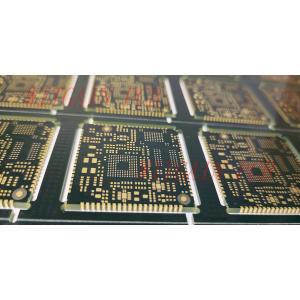
Add to Cart
Half Hole PCB FR4 Substrate 6 Layer PCB GPS Modole Used
Requirements:
1 All dimensions are in MM.
2 Fabricate per IPC-6012A Class2.
3 Materials:
3.1 Dielectric: FR4 Per IPC or equivalent
3.2 Min Tg: 170DEG
3.3 Copper: As per stack up
3.4 UL Rating: 94V0 Minimum
4 Surface finish: ENIG
5 Solder mask material should meet all requirement of the IPC-SM-840E and shall be green in color and applied over bare copper. Vendor may edit solder mask and paste mask as needed.
6 Editing of existing copper layers shall require customer approval.
7 Silkscreen legend to be applied per layer stackup using white non-conductitive epoxy ink.
8 100% continuity testing using database netlist shall be performed.Vendor to identify test passed in secondary side.
9 Vendor to mark date code and logo in legend secondary side.
10 Bow and twist shall not exceed 1.0% of longest side.
11 Vendor to provide panel drawing for customer approval before production
Layer Stackup:

Copper Clad Laminates are classified based on the copper weight, type of resin used, Reinforcement type, glass transition temperature, and various thermal and electrical properties.
The copper foil which is used as the conducting layer of the laminate is available in different specifications as laid out in IPC-4101. This standard also specifies the reinforcement type, the resin system the glass transition temperature range and flammability requirements for making quality copper clad laminate.
Copper Weight: Copper Weight or Copper Thickness in a Printed Circuit Board represents the thickness of 1 ounce of copper rolled out over an area of 1 square foot. It determines the current carrying capacity of a PCB. This is an important parameter that needs to be specified when selecting a copper clad laminate.
Resin: The type of resin used determines the mechanical properties related to stress and strain bearing capacity of the laminate and the thermal characteristics like the rate of expansion and curing properties, which again determine its rate of cross linking among molecular chains which determine its decomposition and glass transition temperature.
| Phenolic | Epoxy | Polyester |
| PTFE | Polyamide/Epoxy | Epoxy/Multi Functional Epoxy |
| Bismaleimide Triazine(BT) | Polyamide | Polyimide Cyanate Ester |
| Cyanate Ester | Epoxy/Phenolic | Flame Resistant |
Reinforcement: The choice of reinforcement used while manufacturing the laminate determines its tooling and drilling characteristics. Cotton and cellulose based laminates do not need to be drilled and can be punched to make a hole in it. Laminates made from a fiber of any kind like, glass, mat glass and quartz require special drilling practices, like closely monitoring the rate of wear of drill bit, the pressure applied to the drill bit and the spindle speed. This is because the thickness and granularity of the glass fibers, the thickness of the copper foil have a huge impact on the number of times a drill bit can be used, which ultimately has an impact on the final cost of making the laminate.
| Cotton Paper | Woven Glass | Mat Glass |
| Cotton Paper/Woven Glass | Woven Glass/Mat Glass | Mat Glass/ Glass Veil |
| Woven Aramid | Woven Quartz Fiber | Woven E-Glass Surface/Cellulose Paper Core |
A copper clad laminate is basically a combination of these layers. The combination determines various mechanical, physical, thermal and electrical properties of the laminate. The properties include the Glass Transition Temperature, the coefficient of thermal expansion. Electrical properties of the board include Dielectric Constant, loss tangent, insulation Resistance, surface resistivity and various other parameters.